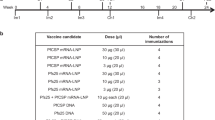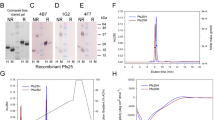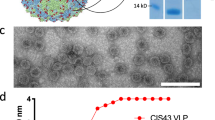Abstract
Malaria vaccines are being developed against different stages in the parasite's life cycle1, each increasing the opportunity to control malaria in its diverse settings. Sporozoite vaccines are designed to prevent mosquito-induced infection2; first generation recombinant or synthetic peptide vaccines have been tested in humans3,4. Asexual erythrocytic stage vaccines, developed to prevent or reduce the severity of disease, have been tested in animals1,5 and in humans6. A third strategy is to produce sexual stage vaccines that would induce antibodies which would prevent infection of mosquitoes when ingested in a bloodmeal containing sexual stage parasites1. Although not directly protective, the sexual stage vaccine combined with a sporozoite or asexual stage vaccine (protective component) could prolong the useful life of the protective component by reducing transmission of resistant vaccine-induced mutants. In areas of low endemnicity, the sexual stage vaccine could reduce transmission below the critical threshold required to maintain the infected population, thereby assisting in the control or eradication of malaria. Transmission of Plasmodium falciparum, the major human malaria, can be blocked by monoclonal antibodies against three sexual stage-specific antigens7–9. We have cloned the gene encoding the surface protein of relative molecular mass Mr 25,000 (25K; Pfs25), expressed on zygotes and ookinetes of P. falciparum. The deduced amino-acid sequence consists of a signal sequence, a hydrophobic C-terminus, and four tandem epidermal growth factor EGF-like domains10–12.
This is a preview of subscription content, access via your institution
Access options
Subscribe to this journal
Receive 51 print issues and online access
$199.00 per year
only $3.90 per issue
Buy this article
- Purchase on Springer Link
- Instant access to full article PDF
Prices may be subject to local taxes which are calculated during checkout
Similar content being viewed by others
References
Miller, L. H. et al. Science 234, 1349–1356 (1986).
Zavala, F. et al. J. exp. Med. 166, 1591–1596 (1987).
Ballou, W. R. et al. Lancet 8545, 1277–1281 (1987).
Herrington, D. A. et al. Nature 328, 257–259 (1987).
Patarroyo, M. E. et al. Nature 328, 629–632 (1987).
Patarroyo, M. E. et al. Nature 332, 158–161 (1988).
Rener, J., Graves, P. M., Carter, R., Williams, J. L. & Burkot, J. R. J. exp. Med. 158, 976–981 (1983).
Vermeulen, A. N. et al. J. exp. Med. 162, 1460–1476 (1985).
Quakyi, I. et al. J. Immunol. 139, 4213–4217 (1987).
Gray, A. Dull, T. J. & Ullrich, A. Nature 303, 722–725 (1983).
Scott, J. et al. Science 221, 236–240 (1983).
Doolittle, R. F., Feng, D. F. & Johnson, M. S. Nature 307, 558–560 (1984).
Walliker, D. et al. Science 231, 1661–1666 (1987).
Graves, P. M., Carter, R., Keystone, J. F. & Seely Jr, D. C. Am. J. trop. Med. Hyg. 33, 212–219 (1984).
Vermuelen, A. N. et al. Molec. biochem. Parasitol. 20, 155–163 (1986).
Low, M. G. & Saltiel, A. R. Science 239, 268–275 (1988).
Sudhof, T. C., Goldstein, J. L., Brown, M. S. & Russell, D. W. Science 228, 815–822 (1985).
Wharton, K. A., Johansen, K. M., Xu, T. & Artavanis-Tsakonas, S. Cell 43, 567–581 (1985).
Greenwald, I. Cell 43, 583–590 (1985).
Jahnke, U., Fisher, E. H. & Alvrod, E. C. Science 229, 282–284 (1985).
Fujinami, R. S. & Oldstone, M. B. A. Science 230, 1043–1045 (1985).
Greenwood, B. M. et al. Trans. R. Soc. trop. Med. Hyg. 81, 478–486 (1987).
Chen, E. Y. & Seeburg, P. H. DNA 4, 165–170 (1985).
Maniatis, T., Fritsch, E. F. & Sambrook, J. Molecular Cloning: A Laboratory Manual 194–195 (Cold Spring Harbor Laboratory, New York, 1982).
Kaslow, D. C. et al. Genomics 1, 19–28 (1987).
Buller, R. M. L., Chakrabarti, S., Moss, B. & Fredrikson, T. Virology (in the press).
Buller, R. M. L., Chakrabarti, S., Cooper, J. A., Ewardczik, D. R. & Moss, B. J. Virol. 62, 866–874 (1988).
Author information
Authors and Affiliations
Rights and permissions
About this article
Cite this article
Kaslow, D., Quakyi, I., Syin, C. et al. A vaccine candidate from the sexual stage of human malaria that contains EGF-like domains. Nature 333, 74–76 (1988). https://doi.org/10.1038/333074a0
Received:
Accepted:
Issue Date:
DOI: https://doi.org/10.1038/333074a0
This article is cited by
-
A human antibody epitope map of the malaria vaccine antigen Pfs25
npj Vaccines (2023)
-
A modular vaccine platform enabled by decoration of bacterial outer membrane vesicles with biotinylated antigens
Nature Communications (2023)
-
Evaluation of the Pfs25-IMX313/Matrix-M malaria transmission-blocking candidate vaccine in endemic settings
Malaria Journal (2022)
-
Global diversity of the gene encoding the Pfs25 protein—a Plasmodium falciparum transmission-blocking vaccine candidate
Parasites & Vectors (2021)
-
Molecular interactions between parasite and mosquito during midgut invasion as targets to block malaria transmission
npj Vaccines (2021)
Comments
By submitting a comment you agree to abide by our Terms and Community Guidelines. If you find something abusive or that does not comply with our terms or guidelines please flag it as inappropriate.



